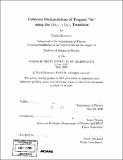Coherent manipulations of trapped 88Sr+ using the 4D5/2 --> 5S1/2 transition
Author(s)
Shewmon, Ruth
DownloadFull printable version (27.20Mb)
Other Contributors
Massachusetts Institute of Technology. Dept. of Physics.
Advisor
Isaac Chuang.
Terms of use
Metadata
Show full item recordAbstract
The ability to control quantum systems with high fidelity is of fundamental importance to a variety of scientific experiments. This thesis describes the frequency stabilization of a laser which is used to coherently manipulate both the internal electronic state and quantum harmonic motion of a trapped 88Sr+ ion via its 4D5/2 <--> 5S1/2 transition. The laser is locked with a linewidth on the order of 1Hz to the resonance of a high-finesse optical cavity. However, acoustic and thermal noise in the cavity broadens the laser's linewidth to several hundreds of Hertz. Despite the noise, we find that the ion's internal electronic state can be manipulated by the laser with a high degree of precision: 17 consecutive Rabi oscillations can be driven with a contrast exceeding 80 percent, and Ramsey inteferometry indicates that phase coherence decays with a time constant of 342±6/[mu]s. Because the laser's dominant spectral broadening occurs on a slow timescale, phase coherence can be maintained by spin echoes for over 5ms. In addition, laser pulses detuned to the first blue motional sideband are able to control the ion's quantum state of motion well enough to use the ground and first excited states as a second qubit. This allows a two-qubit controlled-NOT gate, the quantum analog of an XOR gate and a fundamental building block of quantum computation, to be demonstrated on a single 88Sr+ ion with a classical fidelity of 0.89±0.02.
Description
Thesis (S.B.)--Massachusetts Institute of Technology, Dept. of Physics, 2008. In title on t.p. 88 and + appear as superscript; 5/2 and 1/2 appear as subscript. Includes bibliographical references (p. 89-92).
Date issued
2008Department
Massachusetts Institute of Technology. Department of PhysicsPublisher
Massachusetts Institute of Technology
Keywords
Physics.